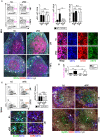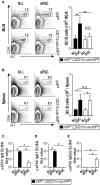Intestinal CD103+CD11b+ cDC2 Conventional Dendritic Cells Are Required for Primary CD4+ T and B Cell Responses to Soluble Flagellin
- PMID: 30386346
- PMCID: PMC6199373
- DOI: 10.3389/fimmu.2018.02409
Intestinal CD103+CD11b+ cDC2 Conventional Dendritic Cells Are Required for Primary CD4+ T and B Cell Responses to Soluble Flagellin
Abstract
Systemic immunization with soluble flagellin (sFliC) from Salmonella Typhimurium induces mucosal responses, offering potential as an adjuvant platform for vaccines. Moreover, this engagement of mucosal immunity is necessary for optimal systemic immunity, demonstrating an interaction between these two semi-autonomous immune systems. Although TLR5 and CD103+CD11b+ cDC2 contribute to this process, the relationship between these is unclear in the early activation of CD4+ T cells and the development of antigen-specific B cell responses. In this work, we use TLR5-deficient mice and CD11c-cre.Irf4fl/fl mice (which have reduced numbers of cDC2, particularly intestinal CD103+CD11b+ cDCs), to address these points by studying the responses concurrently in the spleen and the mesenteric lymph nodes (MLN). We show that CD103+CD11b+ cDC2 respond rapidly and accumulate in the MLN after immunization with sFliC in a TLR5-dependent manner. Furthermore, we identify that whilst CD103+CD11b+ cDC2 are essential for the induction of primary T and B cell responses in the mucosa, they do not play such a central role for the induction of these responses in the spleen. Additionally, we show the involvement of CD103+CD11b+ cDC2 in the induction of Th2-associated responses. CD11c-cre.Irf4fl/fl mice showed a reduced primary FliC-specific Th2-associated IgG1 responses, but enhanced Th1-associated IgG2c responses. These data expand our current understanding of the mucosal immune responses promoted by sFliC and highlights the potential of this adjuvant for vaccine usage by taking advantage of the functionality of mucosal CD103+CD11b+ cDC2.
Keywords: cDC2; dendritic cells; flagellin; immune response; mucosa.
Figures




Similar articles
-
Systemic flagellin immunization stimulates mucosal CD103+ dendritic cells and drives Foxp3+ regulatory T cell and IgA responses in the mesenteric lymph node.J Immunol. 2012 Dec 15;189(12):5745-54. doi: 10.4049/jimmunol.1202283. Epub 2012 Nov 14. J Immunol. 2012. PMID: 23152564
-
CD103-CD11b+ dendritic cells regulate the sensitivity of CD4 T-cell responses to bacterial flagellin.Mucosal Immunol. 2014 Jan;7(1):68-77. doi: 10.1038/mi.2013.25. Epub 2013 May 1. Mucosal Immunol. 2014. PMID: 23632327 Free PMC article.
-
CD103+CD11b+ mucosal classical dendritic cells initiate long-term switched antibody responses to flagellin.Mucosal Immunol. 2018 May;11(3):681-692. doi: 10.1038/mi.2017.105. Epub 2017 Dec 20. Mucosal Immunol. 2018. PMID: 29346347 Free PMC article.
-
Immune responses of TLR5(+) lamina propria dendritic cells in enterobacterial infection.J Gastroenterol. 2009;44(8):803-11. doi: 10.1007/s00535-009-0094-y. Epub 2009 Jun 24. J Gastroenterol. 2009. PMID: 19547909 Review.
-
Intestinal dendritic cells in the regulation of mucosal immunity.Immunol Rev. 2014 Jul;260(1):86-101. doi: 10.1111/imr.12194. Immunol Rev. 2014. PMID: 24942684 Review.
Cited by
-
TLR5 activation in respiratory epithelial cells orchestrate mucosal Th17 response through both indirect and direct pathways.Respir Res. 2025 Mar 17;26(1):104. doi: 10.1186/s12931-025-03186-w. Respir Res. 2025. PMID: 40098159 Free PMC article.
-
A vaccine combination of lipid nanoparticles and a cholera toxin adjuvant derivative greatly improves lung protection against influenza virus infection.Mucosal Immunol. 2021 Mar;14(2):523-536. doi: 10.1038/s41385-020-0334-2. Epub 2020 Aug 17. Mucosal Immunol. 2021. PMID: 32807838
-
Systemically delivered adipose stromal vascular fraction mitigates radiation-induced gastrointestinal syndrome by immunomodulating the inflammatory response through a CD11b+ cell-dependent mechanism.Stem Cell Res Ther. 2023 Nov 13;14(1):325. doi: 10.1186/s13287-023-03562-7. Stem Cell Res Ther. 2023. PMID: 37953266 Free PMC article.
-
TIM-3 increases the abundance of type-2 dendritic cells during Leishmania donovani infection by enhancing IL-10 production via STAT3.Cell Death Dis. 2023 May 18;14(5):331. doi: 10.1038/s41419-023-05848-3. Cell Death Dis. 2023. PMID: 37202419 Free PMC article.
-
B cells and the microbiota: a missing connection in food allergy.Mucosal Immunol. 2021 Jan;14(1):4-13. doi: 10.1038/s41385-020-00350-x. Epub 2020 Oct 26. Mucosal Immunol. 2021. PMID: 33106585 Review.
References
-
- Flores-Langarica A, Marshall JL, Hitchcock J, Cook C, Jobanputra J, Bobat S, et al. . Systemic flagellin immunization stimulates mucosal CD103+ dendritic cells and drives Foxp3+ regulatory T cell and IgA responses in the mesenteric lymph node. J Immunol. (2012) 189:5745–54. 10.4049/jimmunol.1202283 - DOI - PubMed
Publication types
MeSH terms
Substances
Grants and funding
LinkOut - more resources
Full Text Sources
Research Materials
Miscellaneous

